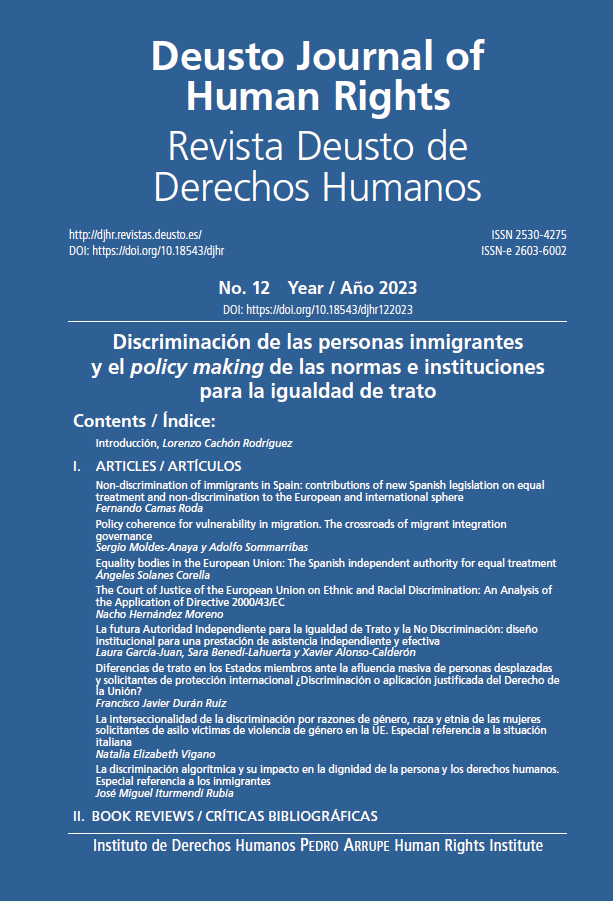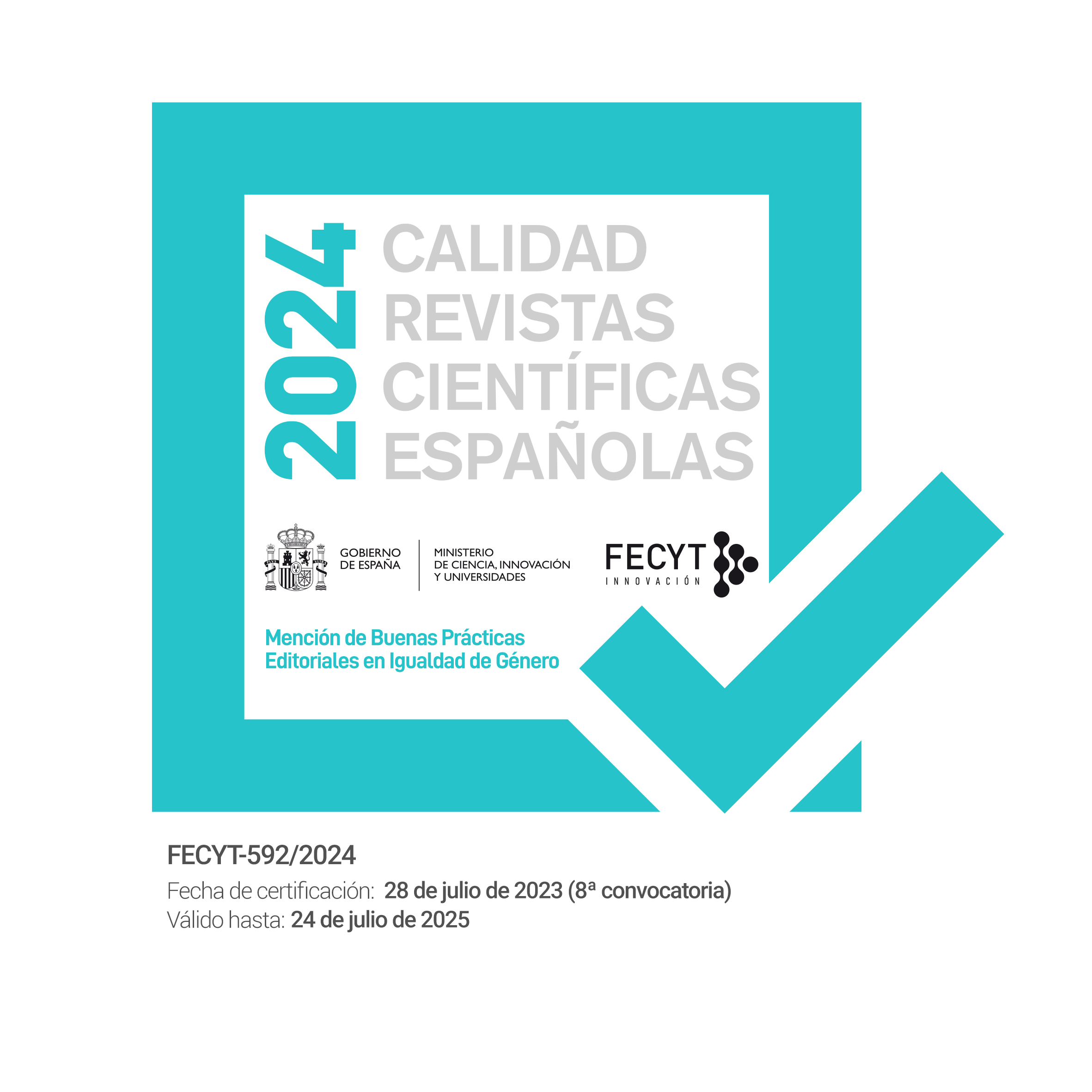Member States in the face of the massive influx of displaced persons and applicants for international protection: Discrimination or justified application of EU law?
Abstract
The aim of this research is to analyze whether the differences in treatment in the different Member States and the dysfunctions and breaches of the rules of the Common European Asylum System, as well as the different solutions adopted by the European Union in the face of applicants for international protection in cases of mass influxes of displaced persons, amount to discrimination contrary to the Geneva Convention, the EU Charter of Fundamental Rights or Directive 2000/43/EC on equal treatment of persons regardless of their racial or ethnic origin, or whether they are justified by EU rules. To this end, we first analyze some differences in treatment in the Common European Asylum System according to the national origin of applicants and the Member State of application; we then examine in depth the Council Decision on the application of the Temporary Protection Directive to Ukrainian nationals displaced by war, determining whether its nonapplication in similar situations such as the crisis in Belarus or the war in Syria constitutes discriminatory treatment, as well as the exclusion from its scope of application of certain groups of non-EU persons in need of international protection. Finally, it analyses whether the “Crisis Regulation” proposed in the EU’s New Pact on Migration and Asylum provides solutions to these cases of differential treatment or discrimination.
Received: 25 September 2023
Accepted: 19 November 2023
Downloads
References
Arenas, Nuria. 2003. Los desplazamientos forzosos de población a gran escala. La Directiva europea relativa al sistema de protección temporal [tesis doctoral inédita]. Universidad de Sevilla.
Azcárraga, Carmen. 2022. «La ‘afluencia masiva de personas desplazadas’ desde Ucrania y su protección temporal en la Unión Europea y en España». Revista General de Derecho Europeo 57: 77-116.
Bakewell, Oliver. 2018. «Conceptualising Displacement and Migration: Process, Conditions and Categories», en The Migration-Displacement Nexus. Patterns, Processes and Policies. Studies in Forced Migration, editado por Khalied Koser y Susan Martin, 14-26. Nueva York: Bergan Books.
Bartomeu, Andrea. 2022. Origen y fundamentos del principio de non- refoulement en el marco del Derecho Internacional de las personas refugiadas. Cizur Menor: Aranzadi.
Beirens, Hans, Sheila Maas, Salvatore Petronella y Maurice van der Velden. 2016. Study on the Temporary Protection Directive: Final Report. Luxemburgo: Publications Office of the European Union.
Borja, Andrea. 2018. «¿Refugiados de primera o segunda clase?», Relaciones Internacionales 36: 31-50.
«Asilo y refugio en la Unión Europea: Agenda Europea de Migración 2015 y retos del Sistema Europeo Común de Asilo (SECA)», Revista de Derecho Migratorio y Extranjería 41: 209-234.
Costello, Cathryn y Michelle Foster. 2022. «(Some) refugees welcome: When is differentiating between refugees unlawful discrimination?», International Journal of Discrimination and the Law 22, n. 3: 244-280.
Durán, Francisco J. 2022. «La regulación de la protección temporal de los desplazados por la guerra de Ucrania y su compatibilidad con otras formas de protección internacional en el contexto de una nueva política migratoria de la UE». Revista de Derecho Comunitario Europeo 73: 951-993.
ECRE. 2023. AIDA Comparative Report: Not there yet: Family reunification for Beneficiaries of International Protection. Acceso el 24 Noviembre 2023: https://ecre.org/aida-comparative-report-not-there-yet-family-reunification-for-beneficiaries-of-international-protection/.
ECRE. 2019. Asylum Statistic in Europe. Factsheet. Acceso el 24 de Noviembre de 2023: https://ecre.org/wp-content/uploads/2020/06/Statistics-Briefing-ECRE.pdf.
EUROSTAT. 2022. Key figures in Europe. Bélgica: EU. Acceso el 24 de Noviembre 2023: https://ec.europa.eu/eurostat/documents/15216629/15358170/KS-EI-22-001-EN-N.pdf/273c56e9-a255-ebc6-fb8d-33f3bb7ca2cf?t=1669211457873.
FRA. 2018. Manual de legislación europea contra la discriminación. Luxemburgo: Unión Europea. Acceso el 24 de Noviembre de 2023: https://www.echr.coe.int/documents/d/echr/handbook_non_discri_law_spa.
FRA. 2022. National legislation implementing the EU Temporary Protection Directive in selected EU Member States (August 2022 update). Acceso el 24 de Noviembre de 2023: https://fra.europa.eu/en/publication/2022/ national-legislation-implementing-eu-temporary-protection-directive-selected-eu.
Garcés, Blanca. 2022. «Por qué esta crisis de refugiados es distinta». CIDOB opinión 728.
Giordano, Antonella. 2018. «De la protección a la securitización: los derechos humanos en la Declaración Unión Europea-Turquía». El Genio Maligno: revista de humanidades y ciencias sociales 22: 12-23.
González-Páramo, Ana. 2022. «Luces y sombras de la acogida europea al exilio ucraniano”. Anuario CEIPAZ 2021-2022, 73-86.
Ineli-Ciger, Meltem. 2016. «Time to activate the Temporary Protection Directive. Why the Directive can play a key-role in solving the migration crisis in Europe». European Journal of Migration and Law 18, n. 1: 1-33
Kienast, Julia. 2022. «‘Crisis rhetoric’ and derogations from the AFSJ: Is EU asylum policy discriminatory or does its implementation reflect the rule of law?». Cuadernos Europeos de Deusto, n. especial 06: 117-143.
La Spina, Encarnación. 2022. «La diferenciación vs. discriminación como línea de tendencia en los regímenes de inmigración y asilo: algunas reflexiones», Revista de la Facultad de Derecho de México 72, n. 284: 193-222.
Meyer, Claus K. y Sebastian Boll. 2018. «Categorising migrants: standards complexities and politics», Anti-Traffiking Review 11: 1-14.
Milios, Georgios. 2022. «La activación de la Directiva sobre protección temporal para las personas desplazadas de Ucrania como consecuencia de la guerra», Revista electrónica de estudios internacionales 44. DOI: https://doi.org/10.17103/reei.44.08.
OAR. 2022. Asilo en cifras 2021. Ministerio del Interior. Acceso el 24 de Noviembre de 2023: https://www.interior.gob.es/opencms/pdf/servicios-al-ciudadano/oficina-de-asilo-y-refugio/datos-e-informacion-estadistica/Asilo_en_cifras_2021.pdf.
Pascual, Laura. 2022. «La criminalización de la asistencia a los solicitantes de asilo en Hungría (a propósito de la sentencia Comisión/Hungría, C-821/19)». Revista de Derecho Comunitario Europeo 71: 169-187.
Porras, José Mª. 2017. «El sistema europeo común de asilo y la crisis de los refugiados. Un nuevo desafío de la globalización». Revista de Estudios Políticos 175: 207-234.
Smirnov, Oleg, Gallya Lahav, John Orbell, Minghua Zhang y Tingyin Xiao. 2022. «Climate Change, Drought, and Potential Environmental Migration Flows Under Different Policy Scenarios». International Migration Review 57, n. 1: 36-67.
Tondo, Lorenzo. 2022. «Embraced or pushed back: on the Polish border, sadly, not all refugees are welcome». The Guardian. Acceso el 24 de Noviembre de 2023: https://www.theguardian.com/global-development/commentisfree/2022/mar/04/embraced-or-pushed-backon-the-polish-border-sadly-not-all-refugees-are-welcome.
Villar, Santiago A. 2017. «Refugiados e (in)solidaridad en la UE: la no aplicación de la Directiva 2001/55/CE». Documents CIDOB 8: 1-7.
Deusto Journal of Human Rights / Revista Deusto de Derechos Humanos is an Open Access journal; which means that it is free for full and immediate access, reading, search, download, distribution, and reuse in any medium only for non-commercial purposes and in accordance with any applicable copyright legislation, without prior permission from the copyright holder (University of Deusto) or the author; provided the original work and publication source are properly cited (Issue number, year, pages and DOI if applicable) and any changes to the original are clearly indicated. Any other use of its content in any medium or format, now known or developed in the future, requires prior written permission of the copyright holder.



3.jpg)
3.jpg)
3.jpg)
.jpg)








